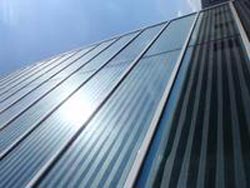Quick and flexible Structuring of Glass Surfaces

Laser technology was used to structure glass for a building façade near Hamburg, Germany. Photo source: Cerion GmbH<br>
The first successful use of this new process can be seen in Norderstedt, near Hamburg, Germany. Nearly 300 m² of the insulated glass façade of a new building were structured on both sides using laser technology. Each glass panel measures 2.8 m by 0.8 m, and weighs approximately 150 kg.
Complex surface decors or large area surface structuring on architectural glass are usually time-consuming and often require processes that are health endangering. For example, wet chemical etching uses hydrofluoric acid, which is highly poisonous. Sandblasting, depending on the degree of frosting or matting required, is time consuming, as several process steps are necessary. For both processes, chemical or sandblasting, the one-use masking is necessary, and a final cleaning step is also needed.
In a joint research project, LZH and Cerion have developed an industrial glass processing with a more economical and much more flexible method. A CO2 laser using infrared laser radiation (10.6 µm wavelength) is used to structure the glass. The focused beam can achieve high local intensities. and vaporizes the material on the glass surface, pinpoint for pinpoint, thus creating periodic microstructures.
At the LZH, scientists in the “Glass Group” (Technologies for Non-metals Department) adapted a technology used for metal processing to fit the needs of glass production. Any shape or form can be transferred to the glass surface using scanner technology for guiding laser beam. This makes it possible to structure glass surfaces at an extremely high speed, since only a small change in the scanner mirror angle is necessary to cover a large distance. Large surfaces can be processed at up to 5.4 square meters per hour with resolutions of 150 dpi. The frosting or matting level can be adjusted in process from transparent to opaque.
Testing of the mechanical characteristics of the lasered glass, such as bending and impulse stability was also part of the process development, especially concerning the requirements placed on static glass components in buildings. Cerion GmbH in Minden, Germany, built a prototype based on the detailed parameter studies carried out by the LZH, and this prototype was used to optimize the process for industrial use. Patents for the system technology have been applied for, and the Cerion GmbH is offering this technology to their international clients under the trademark name of CERILAS. The process is being continually improved and optimized for other application areas, for example non-slip glass surfaces, a process that has already been patented by Cerion.
Laser structuring is highly flexible for both conventional window glass or for thermally pre-stressed float glass, including single-pane safety glass. Safety glass is used for many architectural applications, both inside and out, for example glass façades, glass doors or room partitions, or for designer furniture.
The project „Development of laser-based structuring process for glass surfaces“ has received financial support from the German Federal Ministry of Economics and Technology (BMWi) through the German Federation of Industrial Research Associations “Otto von Guericke” e.V., within the framework of the supportive measure “Central Innovation Program for Medium-Sized Businesses” (ZIM).
Contact:
Business Development & Communications Department
Communications Group
Michael Botts
Public Relations
Tel.: +49 511 2788-151
Fax: +49 511 2788-100
E-Mail: m.botts@lzh.de
The Laser Zentrum Hannover e.V. (LZH) carries out research and development in the field of laser technology and is supported by the Ministry of Economic Affairs, Labour and Transport of the State of Lower Saxony (Niedersächsisches Ministerium für Wirtschaft, Arbeit und Verkehr).
Media Contact
All latest news from the category: Process Engineering
This special field revolves around processes for modifying material properties (milling, cooling), composition (filtration, distillation) and type (oxidation, hydration).
Valuable information is available on a broad range of technologies including material separation, laser processes, measuring techniques and robot engineering in addition to testing methods and coating and materials analysis processes.
Newest articles

NASA: Mystery of life’s handedness deepens
The mystery of why life uses molecules with specific orientations has deepened with a NASA-funded discovery that RNA — a key molecule thought to have potentially held the instructions for…

What are the effects of historic lithium mining on water quality?
Study reveals low levels of common contaminants but high levels of other elements in waters associated with an abandoned lithium mine. Lithium ore and mining waste from a historic lithium…

Quantum-inspired design boosts efficiency of heat-to-electricity conversion
Rice engineers take unconventional route to improving thermophotovoltaic systems. Researchers at Rice University have found a new way to improve a key element of thermophotovoltaic (TPV) systems, which convert heat…



